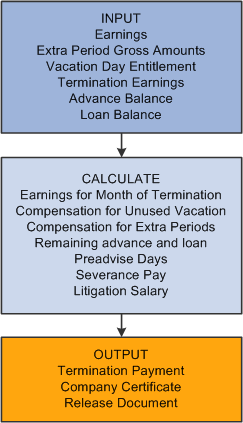Understanding Terminations
This overview discusses:
Termination management.
Terminations in the pay process flow.
Preadvised days nonfulfilled.
Severance pay.
Job litigation salary.
When an employee is terminated, the company pays the employee for any vacation days not taken, for days of the month worked, and for the proportion of the extra period payment earned. The company also subtracts the pending loans or advances repayments.
Often an employee termination can occur under nonstandard conditions. For example:
An employee or employer might preadvise of the termination with fewer days than the law requires.
An employee's severance pay might be different from the amount set by law.
An employee might not agree with the termination reason and pursue litigation.
As demonstrated in these examples, employee terminations are not always straightforward. For such cases in which the termination process has exceptions, the company must determine nonfulfilled preadvise days, severance pay, and litigation salary so that the payroll process can calculate the desired results for termination pay. PeopleSoft Global Payroll for Spain provides functionality that enables you to manage termination information and calculations for these nonstandard conditions.
To terminate an employee, use the Job Data component (JOB_DATA). The system calculates termination pay using the same process list as the regular payroll. You can create specific calendars for termination processing or run termination processing within the calendar group that corresponds to the regular payroll. To ensure proper calculation of termination pay, you must first:
Administer termination pay criteria through the Labor Agreement component.
Define statutory severance days through the Statutory Rates ESP component.
Define nonstandard conditions involving nonfulfilled preadvise days, nonstatutory severance, or litigation salaries through the Manage Terminations ESP component, when applicable.
Terminations in the Pay Process Flow
Image: Terminations in the pay process flow for PeopleSoft Global Payroll for Spain
This diagram shows how the input of various data such as earnings, vacation, advance, and loan balances are used to calculate termination pay, termination letters, and company certificates involved with terminations and the overall pay process flow of PeopleSoft Global Payroll for Spain:

Preadvised Days Nonfulfilled
A preadvise period is the legal number of days that the employee and the employer have to communicate the end of a labor relation before the effective date of the termination. The minimum number of days for a preadvise period depends on various data such as contract type, termination reason, requirements that were established in the employee's labor agreement, and so on. Employees are penalized if they do not fulfill the number of preadvice days and compensated if the employer does not fulfill the number of preadvice days. These amounts are added or deducted from the employee's termination payment as applicable.
Use the Labor Agreement ESP - Terminations page to define the daily salary for preadvised days that the payroll process uses for terminations of labor agreements. Use the Termination Management ESP page to define the number of nonfulfilled preadvised days and who failed to notify within the minimum number of preadvice days.
Severance Pay
Severance pay is a fixed amount of money that the company must pay the terminated employee based on the type of contract that the employee has with the company, less the amount that the employee owes the company for items as loans and advances. If an employee is dismissed for reasons other than disciplinary, the employee has a right to receive severance pay. This amount depends on the number of worked years, daily salary as of the termination date, and termination reason. The employer pays the employee this amount at the end of the labor relation. However, the employee has the right to appeal the severance pay amount through litigation.
Severance pay for terminated employees can be determined by one of the following methods:
Statutory rates can determine the number of days by year to pay for severance and the maximum number of periods to pay for severance, depending on the termination reason.
The labor agreement for the employee can improve the number of statutory days and the maximum number of periods to pay for severance.
The employer and the employee can reach an agreement by which the number of days by year, the maximum number of periods for severance pay, or both is greater than the statutory rate.
The employer and the employee can reach an agreement for a specific amount of severance pay that is greater than the statutory rate.
A judge can impose an amount for severance pay.
Use the Severance Days page in the Statutory Rates ESP component to define statutory days and periods for severance pay as defined by the social security general treasury (Tesorería General de la Seguridad Social [T.G.S.S.]). Use the Labor Agreement ESP - Terminations page to define the daily salary for severance pay and override the statutory values that the payroll process uses for terminations of labor agreements. Use the Termination Management ESP page to override calculated values for severance pay.
Job Litigation Salary
Litigation salary is the salary that the company is required by law to pay the terminated employee if the employee appeals the termination. If an employee appeals termination and the appeal goes to court, that employee has a right to receive job litigation salary for the period between the termination date and the final resolution date of the litigation regardless of the ruling. The job litigation salary is equivalent to the employee's regular salary. If the employee and the company reach a friendly agreement before the appeal goes to court, job litigation salary is not needed.
Use the Labor Agreement ESP - Terminations page to define the daily salary for job litigation that the payroll process uses for terminations of labor agreements. Use the Termination Management ESP page to enter the job litigation information.